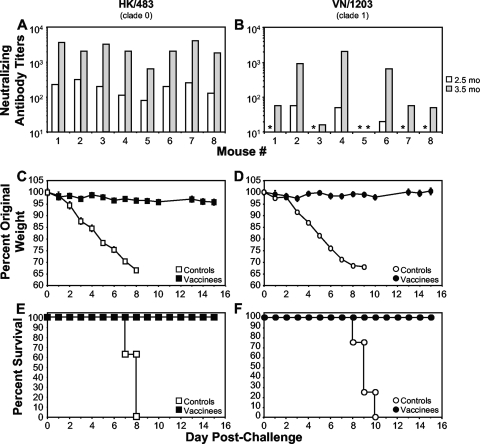FIG. 2.
Induction of heterologous cross-protective immune responses in mice after vaccination with rVSVs expressing H5 HA from the optimal first genomic position. (A and B) Mice (n = 8) were intramuscularly primed and boosted at 2.5 months postprime with 107 PFU of VSV-H5(1) and VSV-NJG-H5(1), respectively. Sera collected from vaccinated mice at 2.5 months postprime (preboost; white bars) or 1 month postboost (3.5 months postprime; gray bars) were subjected to a microneutralization assay (39) against the challenge virus (HK/483[A] and VN/1203 [B]). All mice vaccinated with the negative-control vectors (n = 8) had undetectable neutralizing activity that corresponds to a titer of 10 in this assay (data not shown). Asterisks indicate sera from H5 HA-vaccinated animals with undetectable nAb. (C to F) At 2 months postboost (4.5 months postprime), vaccinated mice were intranasally challenged with either HK/483 (clade 0; n = 8) (C and E) or VN/1203 (clade 1; n = 8) (D and F). (C and D) Pathogenesis was assessed by weight loss and is shown as the average percentage of original prechallenge weight. (E and F) Kaplan-Meier plots depict the percent survival of negative-control mice (controls) or H5 HA-vaccinated mice (vaccinees).

